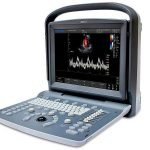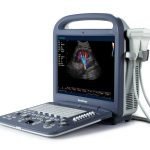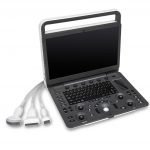Table of Contents
The popularity of portable ultrasound devices is undoubtedly growing day by day. A simple and logical reason is that these mobile systems are indispensable for several healthcare services.
They are proving to be versatile, particularly for smaller labs and clinics. With easy movement across the clinic’s premises, these small devices make you serve more efficiently than a big, motionless machine. Thus, they need less space. Most machines are also moveable by hand and driven by a battery.
Like other ultrasound devices, portable ones are useful for analysis in several disciplines, including cardiology, abdominal, pediatrics, muscular, and vascular. They also are reliable for scrutinizing the development of the fetus and pediatric assessments of a baby’s spine and head.
The compact ultrasounds facilitate quicker yet more precise diagnosis because they offer more significant device quality. An increasing number of physicians recognize the potential of these small devices and are trained to use them for better analysis in their practices.
Thus, it is common for them to look for portable ultrasound devices for sale. This post, as a guide, is written to choose the most suitable ultrasound smartly by comprehending the different features and benefits.
Choosing the Right Portable Ultrasound Devices for Your Clinic
The advancements in image processing, ultrasound design, and probe technology have resulted in various ultrasound uses across healthcare centers. Due to widespread usage, portable ultrasounds are available in different categories, ranging from high-end models to handheld devices.
This also brings in different other factors, such as size and features. So, let’s check out the buying factors you should consider to choose the most suitable portable ultrasound model.
Type/Application
Portable ultrasound devices are helpful in almost any medical situation with less time or space. Their striking mobility makes them ideal for scanning bedside or on the go. For these reasons, these devices are highly advantageous for:
- Anesthesia/Pain Management
- Obstetrics (OB)/Gynecology (GYN)
- Musculoskeletal (MSK)
- Cardiac
- Veterinary
- Vascular
- Emergency
- Critical Care
You cannot buy smartly without knowing the purpose of investing in an ultrasound device. So, start by figuring out the primary goal. In case of more than one purpose, arrange them in descending order of their usage percentages, such as 50% vascular, 25% abdomen, and 25% cardiac.
Despite the overwhelming variety, choosing the right system according to your identified requirements and budget is easy. By matching one such system with the different categories available, you can successfully narrow down the list of preferences.
Regardless of the application, handling a portable ultrasound is the key to choosing the right type. Similarly, knowing which ultrasound device type will likely match these requirements is important. Following are the three types or categories of portable models:
- Handheld or tablet
- Fold-down
- Laptop
Size and Weight
Both of them are critical factors in examining portable ultrasound devices for sale. The size is usually an indicator of its advanced capabilities and performance.
The laptop models have a monitor of 13 to 15 inches, ranging from 6 to 15 pounds. On the other hand, fold-down models come with two transducer ports. They weigh more than the laptop ones by 10-20 pounds.
They are perfect when more than one transducer is used regularly, such as cardio or OB/GYN. Further, the frequency of changing probes is less, which means no potential harm and more efficiency. Handheld models featuring a view monitor weigh less, almost within a pound.
Main Features
There is no need to be too technical here. You only need to know what you must have. For instance, would you require a Doppler and a stress echo for cardiac? How wide-ranging will your analysis be?
Which technology will be required to fulfilling your requirements? Are your patients overweight or need some exceptional features? Find out the exact answers to these questions to know the wanted features!
Budget
You need to recognize that portable ultrasound devices on sale are expensive, ranging from $1,000 to over $100,000. Your search will be significantly narrowed when you know how much you can spend.
Used or New Model
While a used device is more affordable, a new system is more expensive but satisfactory. Nevertheless, several makers, such as Sonoscape, make new models at the cost of a used system.
Many buyers prefer to go with big brands or makers for peace of mind or not to get the desired technologies from smaller manufacturers. Others prefer getting a new device from a small maker. This offers similar or better output over the used or refurbished models and a year of warranty.
Probes
Probes on portable ultrasound devices are similar to those on stationary models. The only significant difference is the connector size. Well, this is smaller in the case of portable models.
Due to the handiness of higher-end probes, such as 4D cardiac and progressive elastography. Remember, the probe’s frequency is indirectly related to its depth.
As a thumb rule, lower frequency probes are for more profound penetration. These are between 2 and 5 MHz. The higher frequency probes are for more cursory and precise imaging, between 10 and 16 MHz.
Battery Power
Many clinicians choose a model with low power, as the ones with high power output are likely to harm the tissue. Ensure that you select a model with sufficient battery backup and several DC ports for charging.
Warranty/Standards
It is wise to look for the safety requirements and certification, ensuring that it fulfills your region’s standards. This will ensure that your patients will never be at risk.
Further, check the warranty time, service contract, and renewal conditions. You should also find out the kind of support the maker provides if there is some issue. Lastly, go for a model with easily accessible and affordable replacement parts.
What Features to Consider Before Buying a portable ultrasound device?
Once you decide on the right portable ultrasound type for the targeted hospital clinical purposes, it is time to balance requirements and budget. Here, you must assess the main features for balancing cost and performance.
To get started quickly, split the brands into four categories: economy, mid-range, high-end, and handheld. While ultrasound technology has become compact, its high-end features only apply to fold-down and laptop systems.
Usually, quicker processing speed and higher frequency are part of the most expensive ultrasounds. However, regarding imaging performance, you should consider features such as better and more imaging options, boosted near-field resolution, 3D/4D capabilities, Doppler sensitivity, more transducers, lightweight, auto measurements, optimization, simple workflows, and structured reporting.
Features in High-End Portable Ultrasound Devices
These devices are expensive but have high-class features.
- Superb image quality
- Premium imaging with advanced technology
- 4D imaging for OB/GYN with Virtual HD or HDLive
- Compound imaging
- Incessant auto-image optimization
- Progressive quantification
- Streamlined workflow
- Single-crystal and advanced linear probes
- 4D echo and transesophageal echocardiography (TEE)
- Smart Doppler
- Needle visualization
- No speckle noise
- Solid State Hard Drive (SSHD)
Features in Mid-range Portable Ultrasound Devices
These machines diagnose quickly during most common scans. They are in high demand due to their reliable performance and affordable price. Thus, this category has the widest variety of models.
- Lightweight
- Lean design
- Tissue Doppler imaging
- 4D options/modes
- Streamlined processes
- Auto-optimization
- Needle visualization
- Probes for adult and pediatric cardiac scans
Feature in Economy Portable Ultrasound Devices
Although they do not having advanced technologies, these models facilitate an optimal negotiation of performance and cost. They are perhaps the most popular models due to their low-price range. The buyers of these models are vets, are bringing the ultrasound technology into their practice, and have restricted advanced technology use (only for basic OB).
- General, OB/GYN, and MSK imaging
- Specific measurements for point-of-care needs
- Auto-optimization
- Rugged design
- Image compounding
- Less speckling
- Good image quality
Top 10 Portable Ultrasound Devices: BUYERS GUIDE 2023
1.Chison ECO 5 ($3,555.00)

This is one of the most affordable and new-color Doppler ultrasound devices for beginners. You can expect better output quality than the other devices in this price range, customized options for improved workflows, and advanced imaging options such as compound and minor speckling.
A notable feature is a 12-inch high-resolution LED monitor with a tilting ability of up to 30 degrees and a wide viewing angle, which is unusual in this category. Most economical LED screens typically have a limited viewing angle.
The device includes urology, vascular, basic cardiac, pediatrics, OB/GYN, small parts, and abdomen measurements. For urology, instead of the typical endocavity transducer, it comes with a rectal linear probe to view the prostate more clearly.
Pros
- Superb imaging quality
- Ease of use and customization
- Highly affordable
- Extended warranty
Cons
- Slow bootup
2. Chison ECO 1
This is the new portable ultrasound device as small as a laptop and the first model in the ECO series. However, it surpasses all the first-generation models in performance and design. It is genuinely made for easy and fast manageability.
Weighing only 4.5 kgs and featuring a Li-ion battery, it works for two hours anywhere. Several physicians use it for urology, vascular, OB/GYN, small parts, pediatrics, and abdomen tests with two transducer ports and software packages.
Some more features include an ergonomic interface and a 12-inch rotating LCD monitor.
Pros:
- Premium design
- Ultra-compact
- User-friendly
- Quick bootup
- Anti-water coating
- Affordable
Cons:
- Only basic use
3. GE Vivid iq
This high-end, 10-pound device inherits the brand’s top-rated and advanced portable cardiovascular models, namely, Vivid i and q. The redesigned model is genuinely made for premium cardiovascular imaging, but it is also capable of vascular, abdomen, small parts, and OB/GYN imaging.
This premium touchscreen model has advanced quantification options such as RAW data, tissue sync, tissue velocity imaging, auto-IMT, and strain rate. It also comes with 4D TEE and ICE transducers, rare in portable models. The closed interface makes it convenient to clean.
Pros:
- Lighter than its predecessors
- Advanced quantification tools
- Superior image quality
- Ease of use
Cons:
- No keyboard
4. Vivid E9
This redesigned version of the Vivid 7 Dimension is admired for 4D cardiac imaging and user-friendly ergonomics. It is a highly customizable, powerful model known for its accelerated volume architecture, meaning improved resolution, and eight times the processing power, meaning a wide field view.
Thus, it is ideal for scanning the heart with reasonable frame rates and complete diagnostic details. You can expect the best 4D cardiac output with a never-easier-before working. With a slim design, a 17-inch tilting swiveling LCD, and an ergonomic keyboard, this one is perhaps both convenient and comfortable.
If you are on a budget, consider getting a used Vivid E9! You will not be disappointed!
Pros:
- Light design
- Speedy performance
- Wide cardiac output
- Several transducers
- Advanced probe technologies
- Ergonomic imaging
Cons:
- Only ideal for cardiac and vascular scans
5. GE Voluson E8
Based on the popular Voluson 730 series, this portable 4D ultrasound device is perhaps the new standard for superb OB/GYN, 4D scans, and radiology. A unique feature available in a few versions is HDLive, an imaging technique for 4D viewing, depth perception, and anatomical reality.
HDLive features a moveable virtual light source showing shadows on the face, which offers an accurate baby view. Some salient features are the 23-inch LED monitor for multi-touch imaging, tailored formats, ergonomic design, and accessible settings for optimal visualization.
The features boost fetal cardiovascular visualization and improve echo exams’ quality, heart function indicators, and arrhythmia assessment. The device has more probes and options than E6.
Pros:
- Super image management
- HDLive
- Full functionality and performance
- Affordable
- Ease of use
Cons:
- Some trial and error initially
6. Sonoscape S2 ($5,999.00)

This is a low-mid range color Doppler device. While it is a shared service device, it is ideal for its 2D high-quality imaging capabilities. The device has advanced imaging capabilities such as speckle reduction and compound imaging.
This portable device is ideal for OB/GYN, ortho, small parts, vascular, abdominal, urology, MSK, breast, urology, pain management, and superficial imaging. Its salient features include post-measurement and software packages, professional reports, 15-inch LCD, two probe sockets, and presets.
Pros:
- Ergonomic design
- Low price
- Superb image quality
- Optimum workflow
- Several transducers
- Different operating modes
Cons:
- No tilting or touchscreen monitor
7. Sonoscape E2 ($6,666.00)

This is an economy-color Doppler ultrasound device for MSK, gynecology, pediatric, cardiac, vet, urology, abdominal, obstetrical, vascular, cephalic, and small exams. It comes with advanced technologies such as multi-beam processing, digital beamformer, and multi-beam processing.
The device encompasses essential to in-depth and complete profile screening with upscale options such as improved needle visualization, auto IMT, auto-image optimization, 15.6-inch LED, panoramic imaging, spatial compounding, and two probe ports.
The E2, unlike E1, fulfills the higher requirements in terms of modes, as it covers a variety of modes, including bi-directional Doppler and simultaneous.
Pros:
- Satisfactory image quality
- Smooth workflow
- Several modes
- Affordable
Cons:
- No tilting or touchscreen monitor
8. Voluson I
This is perhaps an ideal option for starting with a 4D ultrasound system for women’s health. Many sonographers, physicians, and other experts find this one of the best portable devices today.
Keeping up with the competition, this device offers the best image quality and frame rates. Although the price is high, Voluson I has retained its value through its quality. The 11-pound system has fetal heart and volume imaging and many imaging automation options.
This system is perfect for emergencies, point-of-care cases, and fixed exam rooms with battery-powered options or an AC power drive. Key technologies come from the costlier Voluson E8, including STIC and SonoVCAD hearts.
Pros:
- Light
- Advanced performance
- High-end 4D output
- Several 4D probes
Cons:
- Not for full-scale imaging
- No touchscreen
9. Samsung Medison Sonoace R3
This ultra-portable general imaging device is quick and powerful as a device being three times bigger in size. This device is highly portable and bootable in a few seconds with a laptop size.
The image quality and functionality are similar to a premium device. It is intuitive, easy to navigate, and has good software packages for a good workflow. The device has multi-purpose applications, including pediatrics, small parts, abdominal, and obstetrics. More salient features include modes, 15-inch LCD, one-touch optimization, and superb connectivity.
Pros:
- Compact
- Powerful imaging
- Optimized and fast
- User-friendly design
- Affordable
- Many transducers
Cons:
- No touchscreen or tilting
10. Siemens Acuson P500
This robust and compact ultrasound device supports many applications by being at the bedside. Considered an ideal imaging device, Acuson P500 boosts diagnostic accuracy in emergency or Point of Care (POC) situations. In most cases, you can expect striking image quality, quick scanning, and standardized clinical output.
Advanced imaging options are taking patient care to a high level. For example, Dynamic TCE tissue visualizes the most subtle changes in the tissue. In contrast, Dynamic Persistence and Auto Flash boost color sensitivity and limit noise and motion artifacts.
Pros:
- High warranty period (5 years)
- Light
- Great imaging quality
- Quick boot
- Advanced features
- Affordable
Cons:
- No tilting
In Conclusion
Portable ultrasound devices are famous for their compactness, size, advanced functionality, and affordability. They are the choice of emergency departments, radiologists, and private practitioners.
While shopping for the most suitable portable ultrasound for your requirements, having an ideal balance of cost and performance is essential. You must review the different models and shortlist the most reliable and promising ones. For such models, you can consider the official site of cardomedical.
Susan M. Love, MD, MBA has dedicated her professional life to the eradication of breast cancer. What began as a career in the 1970’s quickly turned into a mission and as chief visionary officer of Dr. Susan Love Research Foundation (DSLRF), Dr. Love oversees an active research program centered on breast cancer cause and prevention.



Declan tighe
Hi Susan
What is your opinion of the Drager Evita 500
And if so do you have access to any stock
My Middle East government are
Looking for 500 ana 500 Evita 300
Regards
Declan
00447976436576